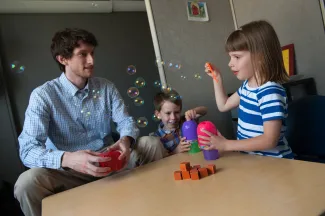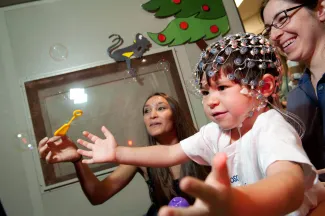Nelson Laboratory Research | Overview


The Nelson Lab focuses on three distinct lines of research, with the overarching goal of elucidating the relation between brain and behavioral (particularly cognitive) development. The laboratory employs a variety of neuroimaging tools, including the electroencephalogram (EEG), functional Near Infrared Spectroscopy (fNIRS), and Magnetic Resonance Imaging (MRI), along with a variety of behavioral tools, including eye tracking.
One line of research focuses on trajectories to autism and the early identification of autism. Here, we see a number of different populations of infants and young children, some with rare genetic variants, others with family histories of autism and still others with various environmental risk factors. The overarching goal here is to develop biomarkers that will permit us to make predictions about which infants will subsequently be diagnosed with autism, and to elucidate the neural mechanisms that lead some children to develop autism and others not (despite comparable risk).
A second line of work concerns the effects of early adversity on brain and behavioral development. There are currently seven projects that reflect this interest. One is focused on infants growing up in families in Boston that experience high levels of stress and adversity. A second is a long-running project based in Bucharest, Romania, focused on children who were abandoned to state run institutions in infancy.
A third line of work is focused on infants and young children growing up in very poor homes in Dhaka, Bangladesh. These three projects facilitate our ability to examine how different types of adversity, occurring at different ages, impact brain and behavioral development.
A fourth project is focused on infants exposed to the novel coronavirus before birth.
A fifth project is the healthy Brain and Child Development study, which represents a 70+ investigator study of both typical and atypical brain development, beginning before birth and continuing to age 10 years. Within hBCD is a particular focus on infants exposed to various substances (e.g., opioids, cannabis) before birth.
A sixth interest concerns the use of EEG and fNIRS, coupled with a host of sensitive behavioral assays, in charting the typical and atypical development of executive functions across the first 1000 days of life.
A final line of work is focused on the development and neural bases of face recognition, with a particular interest in the recognition of facial emotion.
A current project is designed to examine whether individual differences in processing facial emotion in infancy are related to the development of anxiety in childhood. Here we are following a large sample of children who were seen as infants and are now 7-9 years old. We have a rich data set including genetic, imaging, and behavioral data on this sample, and eventually hope to determine if measures obtained in infancy predict which infants will struggle with anxiety in childhood.
Interested in participating in a study?
In every new discovery that we make, through every step forward, we depend upon children and families who support our work by participating in our studies. Your involvement could provide us with valuable insight and can also be a fun, educational opportunity for you and your child. Many of our research studies offer monetary compensation, toys for your child and/or feedback about your child's development.
We invite you to become a part of our team by enrolling in our Participant Registry, which allows us to keep you in the loop about studies for which your child(ren) may be eligible.
